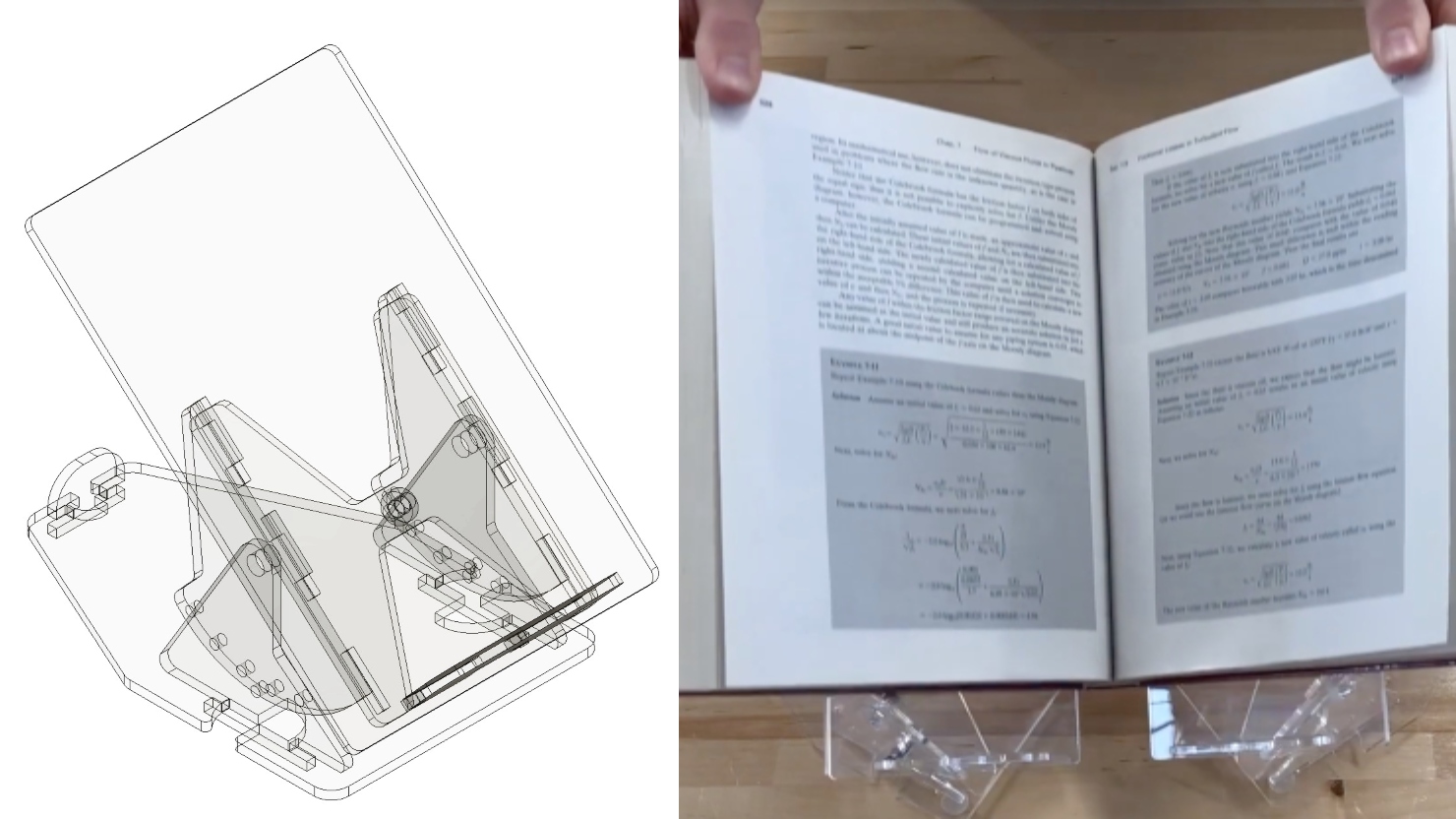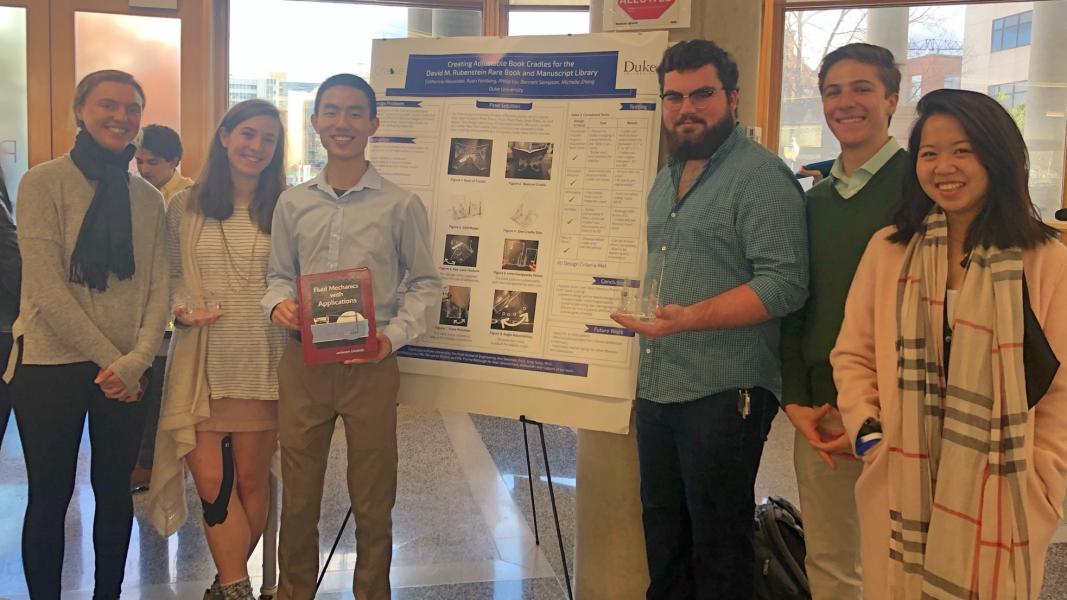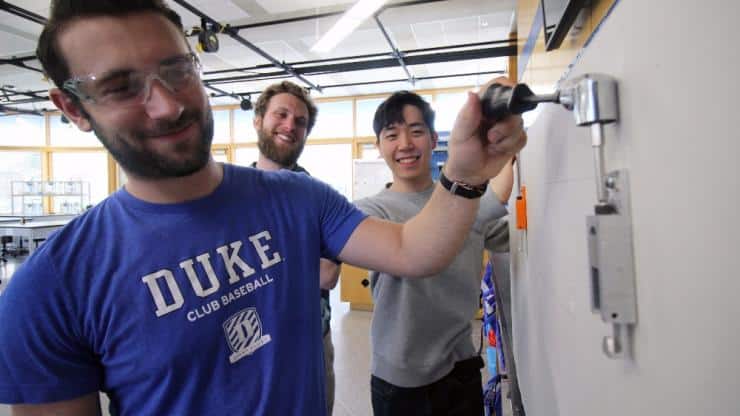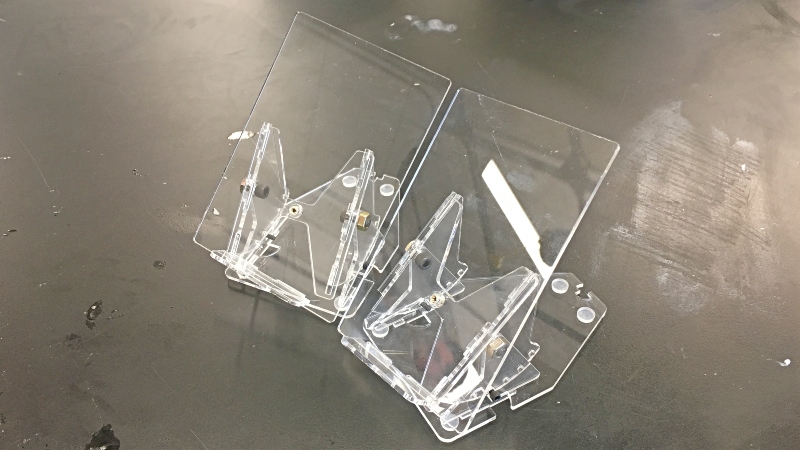‘I Can Do This’—Duke’s First-Year Design Course Boosts Student Self-Efficacy
Two projects from First-Year Design course are patent-pending. Student surveys suggest the course also fosters teamwork, leadership and communication skills.

In fall 2018, Catherine Alexander was working in a team trying to solve a problem faced by curators at Duke University’s David M. Rubenstein Rare Book & Manuscript Library—how to design an inexpensive but effective exhibit cradle to hold a valuable old book safely.
Alexander, like her teammates, wasn’t an engineer or product designer. She was a Duke student in her first semester at the Pratt School of Engineering. Their challenge was a class assignment in Duke’s innovative EGR 101 lab, also known as the First Year Design (FYD) Program.
“The students asked many questions, and they came up with a design that met our needs, looks beautiful, and costs a tenth of our handmade book cradles.”
Margaret Brown
E. Rhodes and Leona B. Carpenter Foundation Exhibits Coordinator
David E. Rubenstein Rare Book & Manuscript Library
With a focus on tackling real-world problems, the course introduces first-year students to engineering and design thinking.
It also has a positive effect on student attitudes and beliefs necessary for successful learning, said Ann Saterbak, director of Duke Engineering’s FYD program and an expert on innovation in engineering education.
In a survey, students who took First-Year Design, showed that by semester’s end, their attitudes about their teamwork, communication and leadership skills, and their own “can-do” belief in their abilities, increased significantly.
For Alexander’s team, the design challenge was displaying rare books. They are rarely the same size or weight, so expensive custom cradles are made for exhibits. Could a better solution be found?
The team worked with their client, Margaret Brown, the E. Rhodes and Leona B. Carpenter Foundation Exhibits Coordinator at the Rubenstein Library. After learning much from Brown, getting advice from a faculty expert in product design, and building prototypes in the tool-filled workshop that was their classroom, the team’s solution met or exceeded the requirements of the brief.

“The students asked many questions,” Brown said. “And they came up with a design that met our needs, looks beautiful, and costs a tenth of our handmade book cradles.”
Deceptively simple, the laser-cut acrylic stand is supremely adjustable—it can be made to rotate, twist and shift in three different ways. The stands were put into use in spring 2019, displaying artifacts of various sizes and shapes in a Rubenstein Library exhibit on campus. When the exhibition travels later this year to New York City, the book cradles will go along.
Their book cradle is now patent pending. That is the second potential patent to launch from First-Year Design: Another first-year student team has applied to protect their design for an adjustable wall hook for professional art museums.
Not every FYD project leads to a patent, nor is it expected to. Instead, the goal is to prepare creative engineers who are inspired and equipped to solve complex problems.
With the introduction of the EGR 101 lab and other new courses, Duke has transformed its undergraduate curriculum to emphasize design, data and decision sciences, computational thinking, mentored research opportunities and increasing each student’s entrepreneurial confidence.
“EGR 101 was a valuable class for me because it gave me an idea of all the different possibilities as an engineer,” said Alexander, who is from Richmond, Va., and hopes to major in mechanical engineering. “It showed me how fulfilling it could be to achieve something working as part of a team. It’s really fueled my love for engineering.”
Saterbak’s previous research has shown that students who engage with authentic engineering problems in their first year exhibit greater self-efficacy—that is, an individual’s belief in their own ability to achieve goals.

She said unpublished survey results from students who took Duke’s First-Year Design Course showed statistically significant increases in self-efficacy related to creativity, engineering skills (tinkering) and engineering design, as well as teamwork, communication and leadership skills.
Measures of grit/perseverance, engineering academic engagement and belief in the value of creativity as a personal trait were unchanged, Saterbak said.
“There is more research to do, and we are staying in contact with these students and continuing to survey them,” Saterbak said. “We want to know if the statistically significant increase in attitudes and beliefs has a lasting effect.”
In the case of the book-cradle team, technical mentor Gregg Twiss, an adjunct associate professor in mechanical engineering and materials science, said he saw that growth firsthand during the 2018 semester.
“The cradle team embraced prototyping and iterative improvement,” he said. “Every week their models got a little better. Ideas that didn’t quite work before were gone, new ideas arrived and other ‘rough edges’ were smoothed out. It was great to see their increasing confidence throughout the semester.”
More about Duke First-Year Design
From First-Year Projects to Patent Applications
Duke Engineering’s signature first-year experience includes a hands-on design course where students take on authentic engineering problems from real-world clients. Here are details of two project teams that have made moves to patent their ideas.
Adjustable Wall Hook
 Challenge: Each time a museum painting needs adjusting, the art must be removed from the wall, increasing the risk of damage.
Challenge: Each time a museum painting needs adjusting, the art must be removed from the wall, increasing the risk of damage.
Goal: Develop an adjustable hanger that can mount art weighing 30-100 pounds, last 20 or more years, and will work with existing D- and J-style hooks.
Client: Nasher Museum of Art, Duke University
Solution: An adjustable three-part bolt design that can bear 400 pounds and costs less than $10 per unit.
Design Team Members:
- Sean Park
- Will Eisner
- Randall Johnson
- Paul Kim
- John Gross
Faculty Technical Mentors:
Status:
- Patent pending
- Prototypes sent to museums across the United States
- Article: First Year, First Patent Pending
Book Cradle
 Challenge: Fragile, rare books must be carefully displayed. Current book cradles are not adjustable, often must be custom-made and are challenging to store.
Challenge: Fragile, rare books must be carefully displayed. Current book cradles are not adjustable, often must be custom-made and are challenging to store.
Goal: Create a single cradle that supports and protects different sizes and weights of rare books, is easy to store and costs less than $50.
Client: David M. Rubenstein Rare Book & Manuscript Library, Duke University
Solution: A cradle with three points of rotation, made of laser-cut acrylic, that can be created in 30 minutes and stores flat.
Team Members:
- Catherine Alexander
- Ryan Feinberg
- Philip Liu
- Bennett Sampson
- Michelle Zhang
Technical Mentors:
Status:
- Patent pending
- Used in a Duke rare-book exhibit, which moves this winter to New York’s book-loving Grolier Club
Links:
- Video: How a Pratt Book Cradle Is Made
- Exhibit website: Five Hundred Years of Women’s Work
